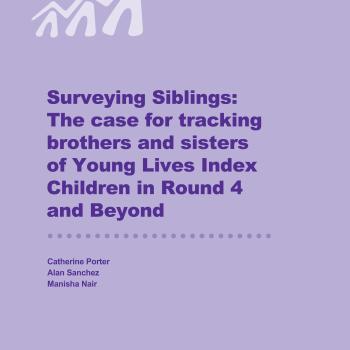
The Young Lives survey has been designed and implemented as a panel survey of 2,000 index children with a comparative cohort of 1,000 older children in each of the study countries. As part of the Round 3 data collection in 2009, information was collected on the next sibling down in three of the study countries, in the domains of anthropometrics, cognitive development, education and time-use. This note explores the potential for extending the sibling cross-section collected in 2009 to a panel in the next survey rounds. There are three main gains that could be achieved from collecting a panel of sibling data:
The sibling is our best comparison of what might have happened to the index child at the same age, under different circumstances. The younger sibling in the current round can be compared to the index child in the previous round to answer a variety of questions around how household or community circumstances affect child outcomes at the same age. For example, the sibling comparison is especially useful if major events occur across the whole country or most of the study sites (macroeconomic events, droughts, food price crisis, introduction of new social programmes, etc.). Collecting sibling data in Round 4 and beyond means that there will be a panel of siblings, not just a panel of index children. The range of questions that can be addressed can now include the influence of past events and circumstances on current outcomes. For example if any sibling migrates, it will be possible to better estimate the impact of this on outcomes than with a single-child panel. Collecting further sibling data would allow research to explore issues within the household that cannot currently be addressed. For example, we can observe whether differences in siblings' outcomes (nutrition, health, cognitive ability for example) narrow or widen as the children age. Plus, we can see whether households try to narrow these differences between their children, or reinforce them; and if they try to narrow, whether household resources constrain them from doing so.These are factors that will need to be considered by the Young Lives team as we start planning for Round 4 data collection and reach a decision about whether to continue to collect data on the sibling cohort as well as the index children.

The Young Lives survey has been designed and implemented as a panel survey of 2,000 index children with a comparative cohort of 1,000 older children in each of the study countries. As part of the Round 3 data collection in 2009, information was collected on the next sibling down in three of the study countries, in the domains of anthropometrics, cognitive development, education and time-use. This note explores the potential for extending the sibling cross-section collected in 2009 to a panel in the next survey rounds. There are three main gains that could be achieved from collecting a panel of sibling data:
The sibling is our best comparison of what might have happened to the index child at the same age, under different circumstances. The younger sibling in the current round can be compared to the index child in the previous round to answer a variety of questions around how household or community circumstances affect child outcomes at the same age. For example, the sibling comparison is especially useful if major events occur across the whole country or most of the study sites (macroeconomic events, droughts, food price crisis, introduction of new social programmes, etc.). Collecting sibling data in Round 4 and beyond means that there will be a panel of siblings, not just a panel of index children. The range of questions that can be addressed can now include the influence of past events and circumstances on current outcomes. For example if any sibling migrates, it will be possible to better estimate the impact of this on outcomes than with a single-child panel. Collecting further sibling data would allow research to explore issues within the household that cannot currently be addressed. For example, we can observe whether differences in siblings' outcomes (nutrition, health, cognitive ability for example) narrow or widen as the children age. Plus, we can see whether households try to narrow these differences between their children, or reinforce them; and if they try to narrow, whether household resources constrain them from doing so.These are factors that will need to be considered by the Young Lives team as we start planning for Round 4 data collection and reach a decision about whether to continue to collect data on the sibling cohort as well as the index children.

